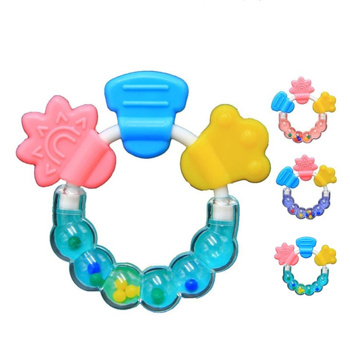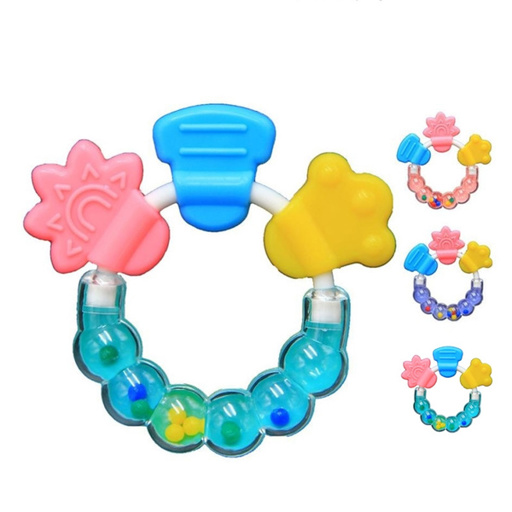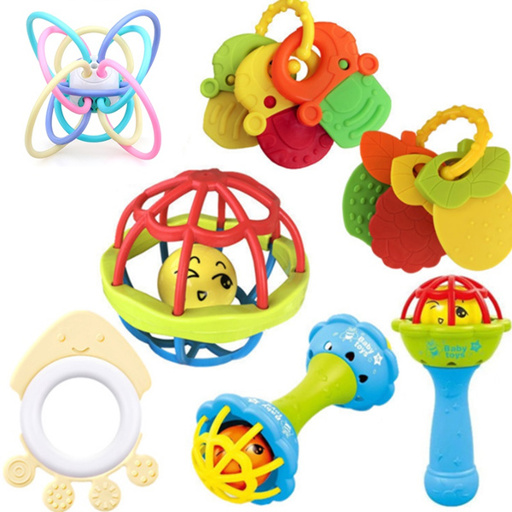Bestsellers for Baby Rattles
Babies usually play with rattles for a few months, typically starting around 3-4 months old and continuing until they are around 9-12 months old. During this time, babies are developing their motor skills and hand-eye coordination, and rattles provide a stimulating and engaging toy for them to explore. However, every baby is different, and some may lose interest in rattles earlier or continue to enjoy them for longer. It's important to remember that these timelines are averages and can vary greatly from child to child. Some babies may even start showing interest in rattles as early as two months old.
The Importance of Rattles in Baby Development
Rattles play a crucial role in a baby's development. They provide sensory stimulation, encourage exploration, and help develop fine motor skills. When babies shake a rattle, they are not only entertained by the sound it produces but also learning cause and effect. They begin to understand that their actions can create a response, which is an essential cognitive milestone. Additionally, rattles can also help babies learn about rhythm and timing as they shake the toy in different patterns. The repetitive motion of shaking a rattle can also be soothing for some babies, providing them with a sense of control and predictability.
Sensory Stimulation
Rattles come in various shapes, sizes, and textures, providing babies with a range of sensory experiences. The different materials and sounds of rattles stimulate their senses of touch, sight, and hearing. The bright colors and contrasting patterns of many rattles attract a baby's attention and help develop their visual perception. Furthermore, the tactile experience of holding a rattle can introduce babies to different textures, from smooth plastic to soft fabric rattles. Some rattles even have additional features like teething surfaces or crinkle materials for added sensory stimulation.
Exploration and Curiosity
Babies are naturally curious and eager to explore their surroundings. Rattles allow them to engage in independent play and discover the world around them. As babies grasp and shake the rattle, they learn about cause and effect, spatial awareness, and object permanence. These skills lay the foundation for more complex cognitive abilities later in life. Moreover, rattles can also encourage babies to explore movement and sound, as they learn how different actions can produce different sounds or cause the rattle to move in different ways.
Fine Motor Skills
Rattles are excellent tools for developing a baby's fine motor skills. As they grasp and manipulate the rattle, they strengthen their hand muscles and improve their hand-eye coordination. The act of shaking the rattle also helps babies refine their motor control and learn to coordinate their movements. Additionally, the process of picking up a rattle, holding it, and moving it around can help babies develop their pincer grasp, which is the ability to use their thumb and forefinger to pick up small objects.
Signs that a Baby is Ready to Move on from Rattles
While rattles are beneficial for a baby's development, there comes a time when they may lose interest in them. Here are some signs that indicate a baby is ready to move on from rattles: Lack of engagement: If a baby consistently shows disinterest in rattles and does not engage with them, it may be a sign that they are ready for more advanced toys. Seeking more challenging activities: As babies grow and develop, they crave new experiences and challenges. If a baby starts to show a preference for toys that require more complex interactions, it may be a sign that they have outgrown rattles. Increased mobility: Once a baby starts crawling or walking, they may become more interested in exploring their environment and interacting with toys that allow for movement. Rattles, which are primarily handheld toys, may no longer hold their attention. Development of new skills: As babies reach new developmental milestones, such as the ability to stack blocks or solve simple puzzles, they may lose interest in rattles as they seek out more mentally stimulating activities. It's also worth noting that as babies grow, their oral exploration phase may decrease, meaning they may be less interested in toys like rattles that they can put in their mouths.
Transitioning to Other Developmental Toys
When a baby shows signs of readiness to move on from rattles, it is essential to provide them with appropriate developmental toys that align with their current stage of development. Here are some suggestions for transitioning from rattles to other toys: Activity gyms: Activity gyms provide a variety of sensory experiences and interactive elements that engage babies in different ways. They often include hanging toys, mirrors, and textures to explore. Stacking toys: Stacking toys help develop a baby's hand-eye coordination and problem-solving skills. They also introduce concepts such as size, shape, and balance. Shape sorters: Shape sorters challenge babies to match shapes with corresponding holes, promoting cognitive development and problem-solving skills. Musical instruments: Introducing musical instruments, such as a mini piano or xylophone, can foster a baby's interest in music and rhythm while encouraging fine motor skills. Activity cubes: Activity cubes feature various interactive elements, such as buttons, sliders, and spinners, that promote sensory exploration and fine motor skills. It's also beneficial to introduce toys that encourage imaginative play, such as dolls or soft animals, as these can help develop social and emotional skills.
Shopping for Developmental Toys on Wish
Wish offers a wide range of affordable and budget-friendly developmental toys for babies. Whether you're looking for rattles, activity gyms, or other stimulating toys, Wish has a variety of options to choose from. Simply download the Wish app or visit the Wish website to browse through the extensive selection of baby toys. With Wish, you can find toys that are specifically designed to support your baby's development at every stage. From sensory toys to motor skill-building toys, Wish has it all. Plus, with the affordable prices offered on Wish, you can provide your baby with a variety of toys without breaking the bank. Additionally, Wish offers customer reviews and ratings for each product, so you can make informed decisions about which toys are best for your baby. So why wait? Start exploring the world of developmental toys on Wish today and give your baby the tools they need to learn, grow, and have fun!
Wish Buying Guide

Bell Gum
Bell Gum is a multi-functional ring gum that is not only practical, but also bright and colorful. It has bells which exercise a baby's hearing power and is made of safe and reliable food-grade silicone material. It has good flexibility with a size that fits into any baby's mouth.
- Long-lasting flavor makes Bell Gum a favorite among users.
- People love the sugar-free aspect of this gum, making it a healthier choice.
- The gum's vivid and unique flavors are highly appreciated by customers.
- Users appreciate the convenient packaging, which is easy to carry around.
- Bell Gum is praised for its ability to freshen breath instantly.
- The product has been commended for its affordability.
- Customers enjoy the soft texture, which does not harden over time.
Baby Silicone Teethers Training Bed Toy Chew Toys Soft Rubber Rattle Teether
This product is a baby silicone teethers training bed toy chew toys soft rubber rattle teether.
These Baby Silicone Teethers Training Bed Toy Chew Toys Soft Rubber Rattle Teethers offer a safe and fun way to help your child learn about different shapes, colors, and textures. They are made of soft silicone and have no sharp edges, making them safe for even the youngest of babies. With age ranges from birth to 24 months all the way up to 14 years old, these toys will grow with your child as they develop their motor skills. The toy includes five animals that can be used to teach children about nature in a playful manner. All in all, this product offers an enjoyable learning experience for your little one!
- Soft Rubber Material: The teether is made of soft rubber, making it gentle on baby's gums and safe for them to chew on.
- Training Bed Toy: This product doubles as a training bed toy, providing both fun and functionality.
- Easy to Hold: The design of the teether makes it easy for little hands to grip, encouraging independent play.
- Durable: Despite its softness, the teether is highly durable and can withstand strong bites from even the most persistent of teething babies.
- Rattle Feature: The built-in rattle feature adds an extra element of entertainment for babies, keeping them engaged and happy.
- Easy to Clean: Parents appreciate how easy this teether is to clean - a crucial factor when dealing with baby products.
- Helps with Teething Pain: Most importantly, this product effectively soothes teething pain, providing relief for both babies and parents.






























